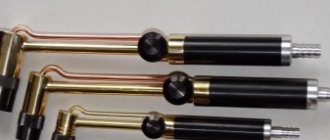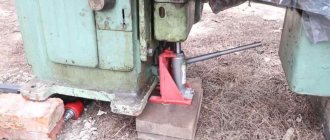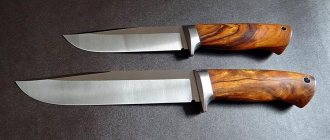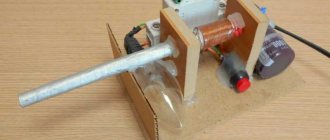Combustion conditions
In order for a homemade burner to work during mining, several requirements must be met.
In particular, oil will burn best when heated and atomized. It is not difficult to fulfill these conditions; the article provides several options for burners that have a powerful flame of fire, and most importantly, a large amount of thermal energy is released. It should be noted that it is allowed to fulfill at least one condition - to provide heating or atomization. True, the efficiency will be somewhat less.
Burner in progress
During the operation of automobile and tractor transport, a significant amount of waste oil is generated.
According to environmental legislation, this oil cannot be poured onto the ground or down the drain, but must be disposed of at special enterprises, incurring significant costs for the budget.
Robert Babington's invention allows us to solve this problem by using the waste for heating premises or for heating technological installations. His burner, being simple in design and accessible to the home craftsman, is reliable and highly energy efficient.
Burner in progress
Types of homemade stoves in development
Engine oil contaminated with impurities will not ignite itself. Therefore, the operating principle of any oil stove is based on the thermal decomposition of fuel - pyrolysis. Simply put, to obtain heat, the waste must be heated, evaporated and burned in the furnace firebox, supplying air in excess. There are 3 types of devices where this principle is implemented in different ways:
- The simplest and most popular direct combustion design with afterburning of oil vapors in an open perforated pipe (the so-called miracle stove).
- Drip furnace using waste oil with a closed afterburner;
- Babington burner. How it works and how to make it yourself is described in detail in our other publication.
The efficiency of heating potbelly stoves is low and amounts to a maximum of 70%. Note that the heating costs indicated at the beginning of the article are calculated based on the indicators of factory heat generators with an efficiency of 85% (to get acquainted with the full picture and compare oil with firewood, you can go here). Accordingly, fuel consumption in home-made heaters is much higher - from 0.8 to 1.5 liters per hour versus 0.7 liters for diesel boilers per 100 m² of area. Take this fact into account when starting to manufacture a furnace for testing.
The pyrolysis stove shown in the photo is a cylindrical or square container, one-quarter filled with used oil or diesel fuel and equipped with an air damper. A pipe with holes is welded on top, through which secondary air is sucked in due to the chimney draft. Even higher is an afterburning chamber with a partition for collecting heat from combustion products.
The principle of operation is as follows: the fuel must be ignited using a flammable liquid, after which the evaporation of the waste and its primary combustion will begin, causing pyrolysis. Combustible gases entering the perforated pipe flare up upon contact with the oxygen flow and are completely burned. The intensity of the flame in the firebox is controlled by an air damper.
This stove has only two advantages during testing: simplicity and low cost and independence from electricity. The rest is all downsides:
- stable natural draft is required for operation; without it, the unit begins to smoke into the room and die out;
- water or antifreeze that gets into the oil causes mini-explosions in the firebox, causing fiery drops to splash from the afterburner in all directions and the owner has to put out the fire;
- high fuel consumption - up to 2 l/hour with low heat transfer (the lion's share of the energy flies into the chimney);
- The one-piece housing is difficult to clean from soot.
Although the potbelly stoves look different, they operate on the same principle; in the right photo, fuel vapors burn out inside the wood stove
Some of these shortcomings can be leveled out with the help of successful technical solutions, which will be discussed below. During operation, you should adhere to fire safety rules and prepare used oil - settle and filter.
The cardinal difference of this furnace is the following:
- a perforated pipe is placed inside a steel casing made from a gas cylinder or pipe;
- fuel enters the combustion zone in the form of drops falling to the bottom of a bowl located under the afterburner;
- To increase efficiency, the unit is equipped with air pressurization using a fan, as shown in the diagram.
Dripper diagram with bottom supply of fuel from the fuel tank by gravity.
The real disadvantage of a drip stove is the difficulty of execution for a beginner. The fact is that you cannot rely entirely on other people’s drawings and calculations; the heater must be manufactured and configured to suit your operating conditions and the fuel supply must be properly organized. That is, repeated improvements will be required.
The flame heats the body of the heating unit in one zone around the burner
The second negative point is typical for supercharged stoves. In them, a jet of flame constantly hits one place in the body, which is why the latter will burn out quite quickly if it is not made of thick metal or stainless steel. But the listed disadvantages are more than offset by the advantages:
- The unit is safe to use because the combustion zone is completely enclosed by an iron casing.
- Acceptable waste oil consumption. In practice, a well-tuned potbelly stove with a water circuit burns up to 1.5 liters in 1 hour to heat 100 m² of area.
- It is possible to wrap the body with a water jacket and convert the exhaust furnace into a boiler.
- The fuel supply and power of the unit can be adjusted.
- Undemanding to the height of the chimney and ease of cleaning.
We suggest you familiarize yourself with: Shower in a country bathhouse Boiler with pressurized air that burns used engine oil and diesel fuel
Homemade devices can be used for any purpose. Very often they are installed in liquid fuel stoves or universal boilers. During manufacturing, it is important to make a nozzle capable of producing a powerful flame. Requirements for the burner that must be met first:
- Low electrical energy consumption.
- Easy to install and easy to use.
- The burner must have high operating efficiency.
- The homemade product should work well even when using low-quality and contaminated fuel.
Using a waste oil burner
Proper operation of the device improves the financial condition of the owner and the life of the unit. It is necessary to ensure its safe use and timely repair.
Instructions
The operating mode of the burner involves temperature changes, which leads to a decrease in the clearance of the fuel lines and a deterioration in the degree of fuel combustion. To increase the operational life of the burner during testing, they draw up a preventive and service plan, shown in the instructions.
Before the operating season the following is carried out:
- setting the combustion mode of petroleum products;
- identification and replacement of worn parts;
- cleaning or changing filter elements;
- analysis of combustion products.
Before the operating season, the combustion mode is adjusted.
For objective assessment, instruments are used: pressure gauge, gas analyzer, soot measurement test.
At the beginning of the heating season, instructions are posted with the daily maintenance schedule for the burner and the frequency of cleaning it from soot.
Safety precautions
To prevent fires and other troubles when operating fuel-burning appliances, follow the following rules:
- the area of contact with the burner is arranged: the walls and ceiling are covered with metal with asbestos lining and the access of unauthorized persons and bystanders is limited;
- the fuel tank is placed at a safe distance;
- when leaks are detected, the flow of flammable materials is blocked;
- the structure is electrically insulated to avoid sparking in the oil spray area;
- The heating unit is located in places that prevent the formation of drafts and air turbulence.
An operating burner must be under the supervision of a designated person.
Trouble-shooting
There are no moving parts in the fuel combustion mechanism. Malfunctions are only possible due to the accumulation of soot, which is removed by routine cleaning. Electrical appliances (fan, oil pump drive, heating elements) are repaired or replaced with working copies.
Malfunctions occur due to soot accumulation.
How to weld a simple stove
There is no point in explaining how to make the standard and most common design, shown below in the assembly drawing. Firstly, the diagram is very clear, and secondly, there is no shortage of information of this kind.
Let's move on to a more complex version of the heater with an afterburner bent at 90° (the angle of rotation can be made larger, but not sharper). The purpose of the event is simple - to organize the extraction of heat from hot flue gases, and not immediately throw them out into the street. The second difference is a drawer with oil instead of a traditional closed container, which is inconvenient to clean. The design of the furnace with dimensions is shown in the drawing.
The dimensions of the unit are arbitrary and may change when selecting pipes of a different section
Step-by-step instructions for assembling a furnace for burning waste look like this:
- Cut blanks for the body, drawer and afterburner. For the latter, the pipes must be cut at an angle of 45°.
- In a profile with a smaller cross-section, cut out one wall with a grinder, and weld plugs on the sides to create an open container. Attach a handle to the front part protruding over the sides of the box.
- Weld the structure as shown in the drawing, drill an air hole on top of the fuel chamber and perforate your bent pipe. The heater is ready.
Here the master attached convection fins from a 40 mm steel strip for better heat transfer.
A few words about how to select the number and diameter of the afterburner holes. In our example, its cross-section is 80 x 80 = 6400 mm²; for the calculation you need to take half - 3200 mm². If you use an 8 mm drill, the area of each hole will be 50 mm². Divide 3200 by 50 and we get 64 pieces that need to be drilled during the assembly process; when setting up, their number will increase.
One of the simplest ways to extract heat is to connect the stove to a horizontal pipe 3-4 m long, running at a slope along the wall of the room. Make sure that there are no wooden shelves or fuel cans placed above it and the heater. It is better to fence the walls near the stove with sheet iron.
Now all that remains is to ignite, warm up and configure the oven. Your task is to achieve minimal emissions of black smoke into the street, indicating a lack of air for combustion. It is necessary to drill 3-5 additional holes in the afterburner and check the operation of the unit again until the emission becomes as transparent as possible.
Burner features
In order to burn the oil effectively, it will need to be heated first and then sprayed. For this purpose, an electric heating element is installed. But the energy consumption will be quite large. And the main thing for you in manufacturing is to achieve minimal losses when using the device. The burner must be a source of very cheap heat, which cannot be realized when using heating elements.
If you can’t warm up the oil first, you need to try to atomize it. The simplest burners made according to the Babington scheme can be successfully used in boilers. The design is extremely simple - fuel flows over a spherical surface. A thin hole is made in the latter; compressed air is supplied through it. It turns out that the oil is blown away from the sphere, small drops are formed, which can be ignited.
Making a drip heater
Most often, craftsmen use old oxygen and propane cylinders with a diameter of 220 and 300 mm, respectively, to assemble droppers. The former are preferable because of their powerful thick walls that can last a long time and not burn out. A pipe made of low-carbon steel (St 3-10) with a wall thickness of 5 mm or more is also suitable.
Select rolled metal for other parts according to the drawing of the furnace with top feed of waste into the combustion zone. The blower fan is a “snail” from a VAZ 2108 cabin heater or its Chinese equivalent, the fuel line is a stainless tube with a diameter of 8-10 mm.
The manufacturing technology is as follows:
- Make a fire bowl from a piece of pipe or take a ready-made steel container. It must be removed through the inspection hatch, so do not make the tray too large.
- Cut openings in the body for the chimney pipe and cleanout hatch. In the latter, make a frame and install the door (possibly bolted).
- Make an afterburner. Take your time to drill all the holes indicated on the drawing; do the bottom 2 rows first. You will complete the rest while setting up the oven.
- Weld a cover and an air duct with a flange for mounting the fan to the afterburner. Attach the fuel supply device as shown in the photo.
- Assemble the heating unit and connect it to the chimney.
We invite you to familiarize yourself with: What styles of clothing are there for men?
The afterburner in the photo is close-up - side and end views
To regulate the heating power, it is necessary to provide control of the fan speed and a device for dosing the fuel supply (as a rule, an automatic drinker with a jet break is used). According to reviews from craftsmen on a popular forum where heat extraction issues are discussed, fuel consumption in the furnace can be monitored visually. The trend is this: if the oil flows in drops at the break in the stream, then less than 1 liter per hour burns, and when a thin stream flows, more than 1 liter per hour.
Different designs of dropper bowls
Pros and cons of the Babington burner
The peculiarity of this type of burner devices is that their positive and negative sides balance each other. As you might have guessed, the main advantage is the use of heavy liquid fuels of any quality. Even with a large number of impurities in the used oil, a homemade air-pressurized burner will function properly (unlike other furnaces made to use similar fuel).
The presence of water or automobile antifreeze in the waste stream (within reasonable limits) is not a hindrance, although minor malfunctions may occur. The fact is that the surface tension of water is higher than that of liquid hydrocarbons. Accordingly, the waste film is more easily torn off from the working surface under the influence of air pressure in a Babington burner. If there is a little water in the oil, then the latter practically does not enter the combustion zone, but flows down into the sump.
Advice. It is still not worth abusing the “omnivorous” nature of the burner device. It is better to pass the waste through a coarse mesh filter before use.
Another pleasant fact for the user is the large selection of types of liquid fuel used. True, when switching from one to another, you will have to reconfigure the burner according to the dosage of fuel and air. Here is a list of these types:
- waste oils and fuels and lubricants of any origin and viscosity - from cars, machine tools and other machines and mechanisms;
- diesel fuel and biodiesel;
- fresh, old and burnt vegetable oils;
- fuel oil;
- light heating oil, kerosene.
The used oil is preheated in a tube surrounding the burner body.
Now about the disadvantages, of which there are also plenty:
- The Babington oil burner is a relatively simple device. But the system of dosed fuel supply and drainage will be more complicated. The circuit involves 2 containers, a pump and a fuel path with combustion intensity control. It is important to ensure the quality of the connections, otherwise the oil will begin to leak.
- When using liquid fuels, especially waste fuel, the boiler room is rarely clean. You must understand that dirt and odors in the furnace room are inevitable. The disadvantage manifests itself in the process of setting up a Babington burner to work together with a homemade stove or boiler. This also includes reconfiguring equipment to switch from mining to diesel, fuel oil or vegetable fuel.
- Occasionally, malfunctions occur during the operation of the burner due to the fact that the nozzle, or more precisely, the tiny air hole, becomes clogged. Most likely, the reason lies on the compressor side. For example, wear of the piston group leads to oil from the crankcase entering the nozzle and can cause failures.
Separately, it is worth mentioning fire safety measures. When performing work related to the installation of an oil burner device, it is recommended to keep a fire extinguisher on hand. The latter must always be located in the boiler room.
Burner operation
The article shows a simplified diagram of the burner, which allows you to understand the principle of its operation. After spraying, the mixture is ignited, and the flame is used for some purpose. You can install this burner in a boiler running on any type of fuel. In principle, no one is stopping you from making a boiler yourself.
To make combustion more efficient, you can make a heating system, just use a low-power heating element in it. In this case, efficiency will increase, heat transfer will improve, and the flame will have a beautiful and even flame.
Advantages and disadvantages of the Babington burner
Each technical device has a number of useful qualities and shortcomings. Obviously, this device has more pros than cons. The main advantage is the utilization of waste raw materials for the greatest benefit. Other advantages of oil and liquid fuel recycling equipment:
- burning waste helps preserve the environment;
- ease of operation and high energy efficiency;
- manufacturing of the device is possible under normal household conditions;
- obtaining heat at a minimum cost of raw materials;
- simple design manufacturing scheme, clear drawings;
- a homemade apparatus can be made from available materials;
- use in workshops and enterprises where a lot of processed raw materials accumulate that require disposal;
- the small dimensions of the burner allow it to be moved if necessary;
- waste and the lowest-grade oil go into the furnace;
- device functionality;
- relative fire safety;
- reuse of used oil.
The main advantage of the burner is the beneficial disposal of used oil.
Flaws:
- It is not recommended for use in cottages and residential premises due to burning and odor;
- the need to equip the premises with a fire extinguisher;
- It is imperative to follow all recommendations for the manufacture of the burner;
- the nozzle or nozzle should be checked periodically (if the holes are clogged with solid particles);
- sensitivity of the nozzle or nozzle to contamination;
- additional power supply to the components of the device (pump, compressor).
Conclusions and recommendations for heat extraction
The main conclusion is this: if you are both a welder and a mechanic, then you will solve the problem of making an oil stove without much difficulty. You will only have to tinker with setting up and organizing the supply of waste in the dropper.
3 types of chimney heat exchangers - convection, air and water economizer
As you understand, simply making a stove using diesel fuel and exhausting it is not enough; you also need to properly take away the maximum heat from it, and not let it fly out uselessly into the chimney. The following methods are practiced:
- As mentioned above, you can lay a chimney at a slope along the entire length of the room, and then take it vertically to the street.
- Use a household fan to blow the housing.
- Scald the body of the potbelly stove with additional heat-removing fins.
- Make and install an economizer (popularly called a register and a boiler) on the chimney - a samovar-type heat exchanger. These are used in solid fuel boilers and consist of several smoke pipes washed from the outside with water.
The simplest way to remove heat from a heated firebox is to weld convection fins
Important point. It is not recommended to blow through the body of the miracle stove for obvious reasons. The water circuit installed on the chimney must be connected to a heating system with forced circulation and an open expansion tank to protect it from boiling. During periodic combustion, the pipelines are filled with antifreeze.
Connection diagram of a water economizer to radiator heating
Advantages of the Babington burner
This design has quite a lot of advantages. The most important thing is that there is no need to pre-clean used oil. After all, you understand that the waste may contain a very large amount of impurities. This is actually why the oil has such a specific black color. You also cannot ignore the second advantage - ease of manufacture. And if you know how to work with tools, you can easily make an effective and simple heat source using cheap fuel.
Waste oil evaporative burners require an additional heat source. Therefore, it is necessary to install heating elements that consume a large amount of electricity. Or you can complicate the design so that the oil is heated and flammable fractions are formed. As for the Babington scheme, it is very simple - you can still do without evaporation, but you just have to use a compressor. This is a design option with lightweight fuel atomization.
DIY waste oil burner
It is recommended that a home craftsman master the manufacture of a heating device if there is a need to heat non-residential premises. The Babington burner, equipped with forced air, is best suited for this purpose. It is capable of processing diesel fuel, fuel oil, kerosene, and vegetable oils.
When changing the heat source, it is enough to change the diameter of the nozzle and adjust the intensity of the air supply into the combustion chamber. The design features make it indifferent to the quality of the working mixture. The fuel may be contaminated with water and metallic inclusions (sawdust).
Preparation and tools
During the preparatory period, materials are sought:
- sheet metal for the heater body and structural parts;
- copper and steel tubes for fuel and air (DN10);
- oil reservoir and sump;
- sanitary tee d=50 mm;
- an oil supercharger (preferably an automobile one) with an engine for it (speed control is required);
- a sphere or hemisphere-evaporator less than 40-45 mm, placed inside the tee;
- Heating element for warming up the oil before starting;
- valves;
- bolts, nuts, fasteners.
The DIYer needs sheet metal for the body.
Tools:
- converter (welding);
- angle grinder (USHRM);
- hacksaw for metal;
- metalworking tools (vises, files, etc.).
Drawing development
Before manufacturing the unit, the burner structure is tied to the place of its operation.
Working diagrams and drawings define the details of the heating system:
- device dimensions;
- heat exchanger design (air or water heating);
- ease of access to the working area of the device for routine cleaning of the combustion chamber;
- method of fuel supply (forced or natural gravity), return collection and, based on this, placement and type of oil container;
- an oxygen supply system for the utilization of unsaturated hydrocarbons into gaseous combustion products.
Drawing of a waste oil boiler.
Assembly
Possible design of the heating device and the sequence of manufacturing steps:
- weld the boiler body from sheet metal or use cylindrical parts and blanks (propane or oxygen cylinders);
- prepare a seat for the burner;
- supply air and fuel;
- a mechanism for initial heating of the oil to 80°C is installed in the lower part of the boiler.
Burner assembly:
- A spray hole d = 0.1-0.3 mm is drilled in the hemisphere for direct fuel supply, or a unit is assembled with a separately manufactured nozzle. The axis must coincide with the center of the duct to create a uniform spray.
- The hemisphere is fixed inside the tee, in the upper part of which a fitting for supplying oil will be welded, and in the lower part there will be pipes for collecting unburned fuel.
- The nozzle is made from a muffled squeegee 10 cm long.
- The air duct is equipped with a compressor to create a pressure inside the combustion chamber of at least 5 bar.
- A copper pipe fuel line is wrapped around the burner 3-5 times to heat the oil.
An oil heating mechanism is installed at the bottom of the boiler.
Airflow adjustment
The oxygen in the combustion chamber is called primary. It ensures oil combustion and the creation of reduced pressure for fuel supply. To ensure complete combustion of the petroleum product, secondary air is pumped into the apparatus using a fan, the flow of which is controlled by a damper and by changing the speed of the electric motor. In an experienced way, automatic changes in operation are achieved so that the motor provides the amount of oxygen depending on the degree of its opening.
Fuel supply to the burner
The oil supply system for the device must be grounded, sealed and not clogged during the manufacturing process. The amount of supplied air and fuel must be balanced and ensure complete combustion of petroleum products; pressure electrical appliances - have parameters corresponding to the design power of the burner. It is recommended to take the oil with a fuel receiver on the float, while preventing mechanical impurities that settle at the bottom of the container from entering the system. Before combustion, the fuel is heated to a temperature of +100…+800°C.
Conversion of industrial burners
It is worth noting that making a waste oil burner from scratch is much easier than remaking industrial designs. After all, you will still need to invest. For example, when converting a diesel fuel burner you will have to spend quite a lot of money. As a result, the design turns out to be very complex and the oil needs to be heated. It is much cheaper to buy a ready-made oil burner or make one yourself.
We invite you to familiarize yourself with: Do-it-yourself stove made from a cast iron bath
Some people try to make a burner from a blowtorch. But this is not a very good option, since its operating principle is very different from what is needed. In a blowtorch, the nozzle warms up, and the oil is forced out of the nozzle due to pressure. Gasoline is a purified fuel, which cannot be said about used oil.
It contains metal impurities, combustion products of diesel fuel or gasoline, as well as other types of contaminants. As a result, the nozzle becomes clogged very quickly. You can, of course, modernize it, but the game is not worth the candle - it is too expensive and labor-intensive. Therefore, it is recommended to give preference to the Babington burner.
Burner assembly
Now let’s come closer to how to make a burner with your own hands during testing. The advantage is obvious - you will receive a high-quality device that will work perfectly and can compete with any industrial design. And most importantly, its cost is very low. You will need a compressor capable of providing a pressure of at least 2 atm.
The ideal option is from an old refrigerator. You also need to have the following materials:
- Fuel tank with a heating element installed in it. The heater will not work constantly; it helps partially warm up the oil.
- The second tank is designed to collect oil not sent to the injector.
- Copper tube to supply air to the burner sphere.
- Pipe for draining waste.
- Pump for pumping excess into the main tank.
- Metal pipe with a diameter of 2 inches for the nozzle.
- Tee for two-inch pipe.
- Materials for spherical nozzle.
When you have prepared all the materials, you can begin manufacturing a burner for solid fuel boilers.
Now let's talk about how to make a working burner and start it up. In fact, after the injector has been manufactured, we can safely say that the main part has been manufactured and only assembly is expected. Now you need to combine everything in the body. And as it you can use a tee and a metal pipe screwed to it.
The sprayer is placed inside the tee and secured with fittings. You need to make a hole in the tee itself; a tube for supplying used oil is placed in it. It is necessary that it ends above the sprayer. The lower element of the tee is used as the outlet tube. An adapter for a thin tube is screwed in here, through which the excess will flow into the drain tank. To organize the supply and removal of oil, you need to use flexible thin copper tubes.
How to make a burner yourself
To understand how to make a Babington burner device, you need to study its design from the drawings. You can find quite a few of these on the Internet, but for manufacturing it is better to adopt the experience of specialists and use a proven prototype for work. Below is a drawing of a burner made and tested by one of the experienced participants in one of the specialized forums:
Now a few words about what the unit can be made from according to this drawing. The author used a regular steel tee with threads for connecting pipes with a diameter of 2 inches (DN50) as a body. Instead of a tee, a cross of the same size will do. The remaining elements are in accordance with the list:
- Any metal part with a hemispherical end can act as a
hemispherical nozzle or a hollow ball for a Babington burner. There are several options - starting from a brass door handle and ending with various spherical nuts. - The nozzle is made from a metal pipe with an external pipe thread, length – 150-200 mm.
- Copper tube with a diameter of 10 mm for the fuel path.
- Metal tube for organizing air supply. Diameter – at least 10 mm.
- Threaded fittings are used to connect a copper tube to the body.
You will also need a small pump to pump used oil. Units from a VAZ car or motorcycle cope well with this task; you just need to ensure their rotation from an electric motor. Any low-power compressor is suitable, including one from a refrigerator, since the pressure in the air path should be low (nominal - about 2 Bar, maximum - 4 Bar).
Advice. To dose or shut off the fuel line, it is necessary to install a special valve on it.
An important operation is to drill a calibrated hole of very small diameter in the improvised nozzle. But first you need to select a drill of the required size, because the power of the future homemade Babington burner will depend on the size of the hole. Calculating power will be discussed in the next section, and how to make a small hole yourself is shown in detail in the video:
Power selection
The trick is that it is quite difficult to independently make such a calculation using formulas. There is data obtained in practice, and it says that different craftsmen make one or more holes with a diameter of 0.1 to 0.3 mm. There is also more accurate information: if you make a burner with 1 hole measuring 0.25 mm, you will be able to achieve a boiler power of up to 15 kW (depending on the type of fuel).
Advice. Do not drill a hole that is too large (more than 0.3 mm), this will lead to poor atomization and combustion of the waste. In addition, the device will be more difficult to ignite, and the consumption of liquid fuel will increase unjustifiably.
Based on these data, you can select the thermal power of the unit by the number of holes. To reach 30-35 kW, you will have to drill not one hole 0.25 mm, but two. Moreover, the distance between them must be maintained at least 8 mm so that the torches of the air-fuel mixture do not extinguish each other. Based on experience, when a Babington burner is operating through one 0.25 mm hole, the approximate oil consumption in maximum mode will be up to 2 liters per hour.
Manufacturing recommendations
When the hole is ready, you need to attach an air supply tube to the ball and install it inside the tee. To ensure a sealed exit of the tube from the housing, you will have to make a threaded plug. A hole is drilled in it, where the tube is inserted. A fitting is cut into the tee from above by soldering, and a copper fuel supply line is connected to it. To heat used oil before burning, we use the following methods:
- An electric heating element with a thermostat is built into the tank, from where the waste material is supplied to the hemisphere.
- The tube leading from the tank makes several turns around the heated nozzle, due to which the fuel passing through it heats up.
A nozzle is first screwed to the tee, and then a copper tube pre-bent into a spiral is put on it. And only then it connects to the fitting. By the way, 2 holes with a diameter of at least 8 mm should be made in the nozzle for the intake of secondary air. A detailed description of how to make a Babington burner yourself is given in the video below:
The lower outlet from the tee is designed to drain used oil into the settling tank. It can be placed directly under the burner, but this is not aesthetically pleasing and unsafe - the flame is too close. It’s better to take the tank to the side and come up with a fitting with a screw plug and a tube to drain the waste. Anyone who is strong in the field of electronics can attach an automatic ignition and safety kit with a controller to the burner.
Electrical ignition can be provided by one or two automotive spark plugs screwed into the beginning of the nozzle. This will make it possible to stop and start the boiler automatically, shutting off and resuming the supply of waste oil and air to the burner. The controller can receive signals from the flame sensor, water temperature in the boiler and fuel level in the tank and, based on them, turn off the pump and close the fuel line valve.
Nozzle
First you need to make a spherical nozzle; fuel will flow through it in the future. Make a hole in the sphere; the diameter should be approximately 0.25 mm. Please note that the power of a homemade burner depends on the diameter. The smaller the diameter, the lower the power and vice versa. All difficulties await you in the manufacture of the nozzle.
But if luck smiles on you and you find a jet with the required diameter, then do not miss the opportunity and place it in the center of the spherical element. If you can’t find a hemisphere, you can use a small piece of sheet metal with a jet attached inside. As a result, you will receive an oil spray nozzle.
Completion of production
The burner will have a powerful flame, but for smooth operation it is important that all designs of external elements are thought out correctly. In the considered option, the waste flows down the sprayer in the shape of a sphere, but most of it returns back to the tank, a small amount ends up in the nozzle. To increase efficiency, it is recommended to install at least a weak heating element in the main tank.
To increase the service life of the unit, it is recommended to treat the connections with high-temperature sealants. It is recommended to install a thermostat on the heating element (if one is not provided). It is enough to warm the oil to a temperature of 70 degrees, there is no point in doing more. The end result should be three nodes consuming power. These include:
- Compressor.
- Oil pump.
- A heating element.
Unfortunately, it is not possible to make a completely energy-independent design, since it is not recommended to exclude a heating element or an oil pump. As for the compressor, without it the burner will not work at all. But you still save a lot on fuel - used oil costs a penny.
Tags: stove, homemade, nozzle
« Previous entry











